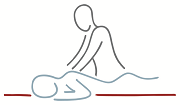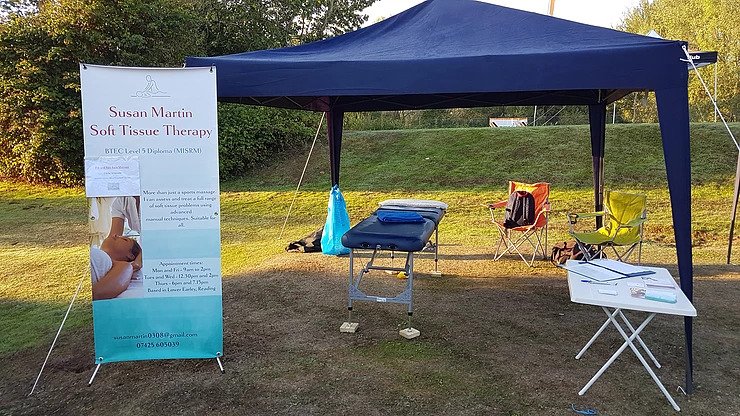With a number of Marathons coming up in the next few weeks and the Triathlon season about to start, here is some information about what you should expect from a pre or post event massage treatment.
Soft tissue therapy and massage has been used for centuries to heal, invigorate and relax the mind and body. In order for our bodies to work efficiently, many complex systems have to work together in a co-ordinated way. Soft tissue therapy can help each of these systems to work optimally, boosting general health and well being. Soft tissue therapy is primarily concerned with muscular and skeletal alignment, how exercise affects the body’s systems and how massage can promote or reduce these effects for the benefit of the exerciser. These aspects are particularly important to athletes during training as well as before and after competition.
Training –
During and after exercise, the body’s systems adapt to cope with the increased stresses placed upon them. In the right amount and frequency, regular exercise (or training) enables the body to deal with higher levels of work and exercise at greater intensities for longer. The application of soft tissue therapy or sports massage during this training phase gives the athlete a number of benefits including the release of muscle tension, improved drainage of waste products and improved posture and flexibility. The therapist can also spot any potential problems caused by the stresses of training and work with the athlete and coach to remedy muscular imbalances, poor training technique or minor injuries. These benefits will enable the athlete to train more frequently and achieve a higher level of fitness and ability before participating in any competitions.
In the run up to an event, massage can be used to help reduce stress. High levels of stress can have a negative effect on sporting performance by increasing muscle tone (tightness) and producing hormone imbalances. Massage can relax the muscles and calm the nervous system in the days before an event. Soft Tissue Therapy can help the athlete with their final preparations by increasing flexibility and range of motion around joints, improving circulation and ironing out any last minute niggles. It can also help with improved sleep and a general feeling of well being. Very important before an important event.
Pre – competition –
The purpose of pre event therapy is to prepare the athlete, both physically and mentally, for the high intensity activity ahead. It should be performed on the day of competition, usually between 1 and 2 hours before the event and should last 10-20 minutes. The athlete is in the final stages of preparation and the therapist’s role is to loosen the muscles by bringing warmth and increased blood flow to them. They should help to focus the athlete without causing significant changes to their bodies. Many athletes use massage as part of their pre-event rituals so the therapist’s routine should stay consistent to avoid impacting the athlete’s mental focus.
Communication between athlete, coach and therapist is vital at this stage to enable the best outcome with minimal fuss. Especially if the therapist and athlete have not worked together before.
Pre-event massage is often administered through clothing at the event site. If oil or lotion is used, it should be wiped off after therapy so as not to impact the athlete’s ability to sweat during the event. Pre-event therapy does not have to be applied to the whole body, and specific areas can be targeted. The goal is for the athlete to leave the therapist feeling prepared for the competition, not lethargic or too relaxed. Therefore all techniques should be performed in an up-tempo pace, avoiding deep pressure or relaxing techniques.
Tapotement is often used pre-event to stimulate the sensory nerve endings in the skin and produce feelings of exhilaration or “get up and go”. Hacking is very effective in increasing blood flow through the muscles thereby warming and relaxing them. It is no substitute for a thorough warm up that the athlete should perform before any event. Another common technique used at this time is Soft Tissue Release (STR). This stretching technique can be used quickly and specifically without the use of lubricants so is ideal for pre- competition. It is a very versatile technique and can be administered during the warm up phase, sitting or standing and using dynamic event specific movements to effectively target the areas of the body that need releasing.
Post – Competition –
The purpose of post event therapy is to help the athlete to recover from their high intensity exercise. This should be performed between 30 minutes and 24 hours after the event. At long races such as Marathons or Triathlons, there may be massage therapists stationed at the finish line to treat athletes after they have finished their cool-down exercises.
The therapy should be fairly brief at up to 30 minutes long (often 10-15 mins is enough) and include techniques to enhance circulation and calm the muscles after their intense activity. Massage will improve the venous return of blood and lymphatic circulation. This will refresh the muscles with fresh oxygenated blood and help to flush out toxins such as carbon dioxide and lactic acid. This should help the athlete to avoid Delayed Onset Muscle Soreness over the coming days. Massage can also help the muscles to regain their normal resting tone and can stimulate the parasympathetic nervous system which improves the immune system.
All these things will help the athlete to feel better recovered from their exertions. Post event therapy should be light, mainly using long, slow strokes to calm muscles and nerves. Any deep tissue work should be avoided as the muscles will have experienced micro trauma during the event. This work should be reserved for a few days later at a therapeutic session. Stretching techniques such as M.E.T. are very useful at this stage to restore muscles to their normal resting lengths.
If any injuries are suspected or the athlete has been adversely affected by the race (heat stroke, dehydration etc.) then the therapist should seek medical attention for them.
If you would like to discuss how I can help you to prepare for, or recover from your events, please get in touch.

